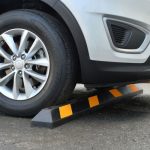Overview
Introduction to road bumps
Road bumps, also known as speed bumps or speed humps, are physical traffic calming devices placed on roads to slow down vehicles. They are typically made of asphalt or concrete and are designed to create a noticeable change in the road surface, causing drivers to reduce their speed. Road bumps play a crucial role in ensuring traffic safety by reducing vehicle speeds, especially in areas with high pedestrian activity or near schools and residential areas. By forcing drivers to slow down, road bumps help prevent accidents and provide a safer environment for both pedestrians and motorists. Additionally, road bumps can also help in controlling traffic flow and reducing noise pollution. Overall, road bumps are an important tool in promoting road safety and enhancing the overall quality of transportation infrastructure.
Purpose of road bumps
Road bumps, also known as speed bumps, serve an important purpose in ensuring traffic safety. These raised structures are strategically placed on roads to slow down vehicles and enforce speed limits. The main purpose of road bumps is to reduce the speed of vehicles, especially in areas with high pedestrian activity, school zones, or residential neighborhoods. By forcing drivers to slow down, road bumps help prevent accidents, minimize the severity of collisions, and create a safer environment for both drivers and pedestrians. Additionally, road bumps can also serve as a visual reminder for drivers to stay alert and cautious while navigating through potentially hazardous areas. Overall, the purpose of road bumps is to promote responsible driving behavior and enhance road safety.
Benefits of road bumps
Road bumps, also known as speed bumps, play a crucial role in ensuring traffic safety. One of the main benefits of road bumps is that they effectively slow down vehicles, forcing drivers to reduce their speed. This helps to prevent accidents, especially in areas with high pedestrian activity or near schools. Road bumps also serve as a visual reminder for drivers to be cautious and alert while driving. Additionally, road bumps can help to control traffic flow by discouraging speeding and encouraging drivers to follow speed limits. Overall, road bumps are an important tool in promoting safer roads and protecting the well-being of both drivers and pedestrians.
Types of Road Bumps
Speed bumps
Speed bumps, also known as speed humps or speed breakers, are an essential tool in ensuring traffic safety. These raised sections of road are strategically placed to slow down vehicles and reduce speeding. By forcing drivers to slow down, speed bumps help prevent accidents and promote safer driving habits. They are commonly found in residential areas, school zones, and parking lots, where pedestrian safety is a top priority. Speed bumps serve as a visual reminder for drivers to be cautious and attentive, encouraging them to adhere to speed limits and be aware of their surroundings. Overall, speed bumps play a crucial role in maintaining traffic safety and protecting both drivers and pedestrians.
Speed humps
Speed humps are an essential tool in ensuring traffic safety on roads. These raised platforms are strategically placed to slow down vehicles and encourage drivers to adhere to speed limits. By forcing drivers to reduce their speed, speed humps help prevent accidents and minimize the severity of collisions. They are particularly effective in residential areas, school zones, and areas with high pedestrian activity. Speed humps serve as a visual reminder for drivers to exercise caution and prioritize the safety of themselves and others on the road.
Rumble strips
Rumble strips, also known as sleeper lines or alert strips, are a vital road safety feature that plays a significant role in ensuring traffic safety. These strips are designed to alert drivers of potential hazards, such as approaching intersections, sharp turns, or pedestrian crossings. When vehicles pass over rumble strips, they produce a vibration and audible noise, alerting drivers to slow down and pay attention to the road ahead. This simple yet effective measure helps prevent accidents by providing a physical and auditory warning to drivers, encouraging them to reduce their speed and remain vigilant. Rumble strips are particularly useful in areas with high accident rates or where speeding is a common problem. By incorporating rumble strips into road design, authorities can enhance road safety and reduce the risk of accidents, ultimately saving lives.
Installation and Design
Proper placement of road bumps
Proper placement of road bumps plays a crucial role in ensuring traffic safety. Road bumps are designed to slow down vehicles and encourage drivers to be more cautious while driving. When road bumps are placed strategically, such as near schools, residential areas, or areas with high pedestrian traffic, they can effectively reduce the speed of vehicles and prevent accidents. However, it is important to consider the visibility and signage of road bumps to ensure that drivers are aware of their presence. Additionally, road bumps should be placed at appropriate intervals to avoid causing discomfort or inconvenience to drivers. By carefully considering the placement of road bumps, we can create safer roads and promote responsible driving behavior.
Design considerations
When it comes to designing road bumps, there are several important considerations that need to be taken into account. Firstly, the height and width of the bump should be carefully determined to ensure that it effectively slows down vehicles without causing discomfort or damage. Additionally, the placement of road bumps should be strategic, taking into consideration factors such as visibility, speed limits, and pedestrian safety. Furthermore, the materials used for constructing road bumps should be durable and able to withstand heavy traffic. Lastly, proper signage and markings should be installed to alert drivers of the presence of road bumps and to ensure their effectiveness in promoting traffic safety.
Materials used in road bump construction
Road bumps are an essential component of traffic safety measures, and their construction requires the use of specific materials. The most commonly used material for road bumps is rubber, which provides durability and flexibility to withstand heavy vehicles. Rubber road bumps are also resistant to weather conditions, ensuring their longevity. Additionally, concrete is another material used in road bump construction, particularly for high-traffic areas. Concrete road bumps offer strength and stability, making them suitable for heavy-duty vehicles. Overall, the choice of materials in road bump construction plays a crucial role in ensuring their effectiveness in maintaining traffic safety.
Effectiveness of Road Bumps
Reducing vehicle speed
One of the key benefits of road bumps is their ability to reduce vehicle speed. By strategically placing road bumps in areas where speeding is a concern, drivers are forced to slow down, improving overall traffic safety. Road bumps act as a visual and physical deterrent, reminding drivers to adhere to the speed limit and be cautious while driving. This helps prevent accidents and ensures the safety of pedestrians and other road users. Additionally, road bumps are particularly effective in residential areas, school zones, and areas with heavy pedestrian traffic, where maintaining lower speeds is crucial. Overall, road bumps play a vital role in reducing vehicle speed and promoting safer roads.
Enhancing pedestrian safety
Pedestrian safety is a crucial aspect of ensuring overall traffic safety. Road bumps play a significant role in enhancing pedestrian safety by slowing down vehicles and creating a safer environment for pedestrians to cross the road. These bumps act as a visual and physical reminder for drivers to reduce their speed and be more cautious in areas with high pedestrian activity. By implementing road bumps strategically in residential areas, school zones, and busy pedestrian crossings, we can effectively reduce the risk of accidents and protect the lives of pedestrians. It is essential to prioritize the installation and maintenance of road bumps as part of comprehensive traffic safety measures.
Preventing accidents
One effective way to prevent accidents on the road is by installing road bumps. Road bumps, also known as speed bumps or speed humps, are raised sections on the road that force drivers to slow down. They are strategically placed in areas where speeding is a common problem, such as residential areas or school zones. By slowing down the speed of vehicles, road bumps help to reduce the risk of accidents and protect pedestrians and other road users. Additionally, road bumps serve as a visual reminder for drivers to be cautious and attentive while driving. Overall, road bumps play a crucial role in ensuring traffic safety and preventing accidents.
Controversies and Challenges
Impact on emergency vehicles
Road bumps can have a significant impact on the response time of emergency vehicles. While road bumps are designed to slow down vehicles and ensure traffic safety, they can also cause delays for emergency vehicles such as ambulances and fire trucks. These vehicles require quick and efficient movement to reach their destinations and provide timely assistance. However, road bumps can slow down their progress and hinder their ability to navigate through traffic smoothly. Therefore, it is crucial to carefully plan the placement and design of road bumps to minimize the impact on emergency vehicles and ensure their prompt response to emergencies.
Noise pollution
Noise pollution is a significant concern when it comes to road bumps and traffic safety. Road bumps are often designed to produce a distinct sound when vehicles pass over them, alerting drivers to slow down and be cautious. This audible warning helps reduce the risk of accidents and promotes safer driving habits. Additionally, road bumps can help mitigate noise pollution caused by speeding vehicles, as they force drivers to slow down, resulting in reduced engine noise and tire screeching. By addressing noise pollution through the installation of road bumps, we can contribute to creating quieter and safer road environments for both drivers and pedestrians.
Maintenance and repair
Maintenance and repair play a crucial role in ensuring the effectiveness of road bumps in promoting traffic safety. Regular maintenance is necessary to keep road bumps in good condition and prevent any potential hazards. This includes inspecting and repairing any damages or wear and tear on the road bumps, as well as ensuring proper installation and alignment. Additionally, regular cleaning and clearing of debris around the road bumps is essential to maintain their visibility and effectiveness. By prioritizing maintenance and repair, we can ensure that road bumps continue to serve their purpose in enhancing road safety for all motorists.
Conclusion
Summary of road bump benefits
Road bumps play a crucial role in ensuring traffic safety. They are designed to slow down vehicles, forcing drivers to reduce their speed. This helps to prevent accidents and promotes safer driving habits. Road bumps also serve as a visual reminder for drivers to be cautious and alert while on the road. Additionally, they can be strategically placed in areas with high pedestrian activity, such as school zones or residential neighborhoods, to enhance pedestrian safety. Overall, road bumps are an effective traffic calming measure that contributes to the overall safety and well-being of road users.
Importance of proper installation and maintenance
Proper installation and maintenance of road bumps are crucial in ensuring traffic safety. Road bumps play a significant role in controlling vehicle speed and reducing accidents on the road. When road bumps are installed correctly, they can effectively slow down vehicles and prevent drivers from exceeding the speed limit. Regular maintenance of road bumps is essential to ensure they remain in good condition and continue to serve their purpose. This includes repairing any damages, repainting the bumps for visibility, and ensuring they are free from debris or obstructions. By prioritizing the proper installation and maintenance of road bumps, we can create safer roads for everyone.
Future developments in road bump technology
In the future, we can expect significant advancements in road bump technology to further enhance traffic safety. One potential development is the integration of sensors and smart technology into road bumps. These sensors can detect the speed and weight of vehicles, allowing the road bumps to automatically adjust their height and stiffness to provide the optimal level of resistance. Additionally, road bumps could be equipped with LED lights to improve visibility, especially during nighttime. Furthermore, the use of eco-friendly materials in road bump construction could help reduce environmental impact. Overall, future developments in road bump technology have the potential to revolutionize traffic safety and make our roads even safer for everyone.






